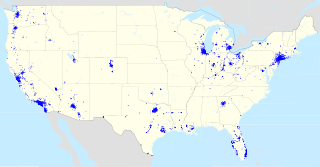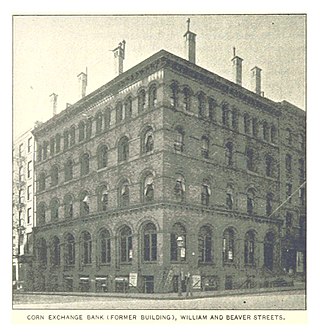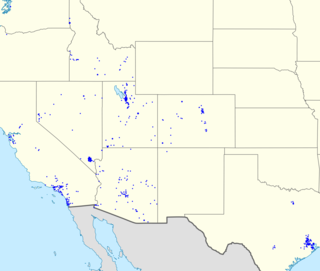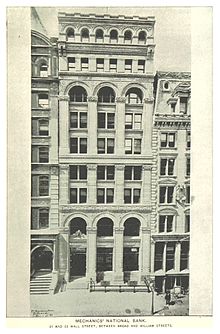Chemical Bank, headquartered in New York City, was the principal operating subsidiary of Chemical Banking Corporation, a bank holding company. In 1996, it acquired Chase Bank, adopted the Chase name, and became the largest bank in the United States. Prior to the 1996 merger, Chemical was the third-largest bank in the U.S., with $182.9 billion in assets and more than 39,000 employees. In addition to operations in the U.S., it had a major presence in Japan, Germany, and the United Kingdom. It was active in both corporate banking as well as retail banking as well as investment banking and underwriting corporate bonds and equity.

JPMorgan Chase Bank, N.A., doing business as Chase, is an American national bank headquartered in New York City that constitutes the consumer and commercial banking subsidiary of the U.S. multinational banking and financial services holding company, JPMorgan Chase. The bank was known as Chase Manhattan Bank until it merged with J.P. Morgan & Co. in 2000. Chase Manhattan Bank was formed by the merger of the Chase National Bank and the Manhattan Company in 1955. The bank merged with Chemical Bank New York in 1996 and later merged with Bank One Corporation in 2004 and in 2008 acquired the deposits and most assets of Washington Mutual. In May 2023, it acquired the assets of First Republic Bank.

Frost Bank is an American bank based in San Antonio that is chartered in Texas, with 155 branches and 1,700 automated teller machines in the state. It is the primary subsidiary of Cullen/Frost Bankers, Inc., a bank holding company. It is one of the 60 largest banks of the country by total assets.
Irving Trust was an American commercial bank headquartered in New York City that operated between 1851 and 1988 when it was acquired by Bank of New York. From 1965, the bank was the principal subsidiary of the Irving Bank Corporation.

Manufacturers Hanover Corporation was an American bank holding company that was formed as parent of Manufacturers Hanover Trust Company, a large New York City bank formed through a merger in 1961. After 1969, Manufacturers Hanover Trust became a subsidiary of Manufacturers Hanover Corporation. Charles J. Stewart was the company's first president and chairman.

The Corn Exchange Bank was a retail bank founded in 1853 in New York state. Over the years, the company acquired many community banks.

The Knickerbocker Trust was a bank based in New York City that was, at one time, among the largest banks in the United States. It was a central player in the Panic of 1907.

The Brooklyn Trust Company was a bank headquartered in New York City, United States. Chartered in the then-independent city of Brooklyn in 1866, the Brooklyn Trust Company originally offered trust management and estate management services but also functioned as a commercial bank. The Brooklyn Trust Company acquired over a dozen smaller banks throughout its existence, merging with the Manufacturers Trust Company in 1950.

Huntington Bancshares Incorporated is an American bank holding company headquartered in Columbus, Ohio. The company's banking subsidiary, The Huntington National Bank, operates 1047 banking offices, primarily in the Midwest: 459 in Ohio, 290 in Michigan, 80 in Minnesota, 51 in Pennsylvania, 45 in Indiana, 35 in Illinois, 32 in Colorado, 29 in West Virginia, 16 in Wisconsin and 10 in Kentucky.

Zions Bancorporation is a national bank headquartered in Salt Lake City, Utah. It operates as a national bank rather than as a bank holding company and does business under the following seven brands: Zions Bank, Amegy Bank of Texas, California Bank and Trust, National Bank of Arizona, Nevada State Bank, Vectra Bank Colorado, and the Commerce Bank of Washington. It has 416 branches and over 1 million customers. It was founded by the Church of Jesus Christ of Latter-day Saints in 1873, although the church divested its interest in the bank in 1960.
The New York Trust Company was a large trust and wholesale-banking business that specialized in servicing large industrial accounts. It merged with the Chemical Corn Exchange Bank and eventually the merged entity became Chemical Bank.
Consolidated National Bank of New York was a bank operating in New York City. Also referred to in the press as Consolidated National Bank, the institution was organized on July 1, 1902, with capital of $1 million. Wrote The New York Times, the bank was "founded with the idea of cornering the business of the Consolidated Exchange and its brokers." The bank opened for business at 57 Broadway on September 22, 1902, and a year later the bank took out a five-year lease at the Exchange Court Building. In 1906, the Consolidated Stock Exchange withdrew its deposits with the Consolidated National Bank. In 1909, the bank voted to acquire the assets of Oriental Bank and merge them with Consolidated, creating the National Reserve Bank. The Consolidated name was operative for a short time afterwards.
The National Reserve Bank of the City of New York was a New York City bank in that was formed from a merger of Consolidated National Bank and Oriental Bank in 1909 and operated until acquired by the Mutual Alliance Trust Company in 1914.
The Chatham Phenix National Bank and Trust Company was a bank in New York City connected with the Chatham Phenix Corporation. Its predecessor Chatham and Phenix National Bank was formed in 1911 when Chatham National Bank paid $1,880,000 to absorb the asset of the Phenix National Bank. The bank grew significantly as it absorbed smaller banking institutions, such as Mutual Alliance Trust Company and Century Bank in 1915, at which point Chatham and Phenix National Bank became the "first national bank to operate branches in the same city with the main bank."

The Continental Bank and Trust Company of New York was a financial institution based in New York City, New York, United States. It was established in 1870 as the German-American Bank, which became the Continental Bank of New York. Originally in the Equitable Building at 120 Broadway, the bank was later headquartered at 50 Wall Street, 25 Broad Street, and starting in 1932 the Continental Bank Building It became known as the "brokers bank" for its collaboration with Wall Street brokers and investment banking interests. The institution was renamed the Continental Bank and Trust Company of New York around 1929, at which point it was involved in extending its business with acquisitions of commercial banking and fiduciary operations. Acquired banks included the Fidelity Trust Company in 1929, International Trust Company and Straus National Bank and Trust Company in 1931, and Industrial National Bank later that year. In 1947, the bank earned $804,000 in net profits. As of December 31, 1947, Continental had total resources of $202,000,000, and deposits of $188,000,000. It merged with the Chemical Bank and Trust Company in 1948.
The Astor Trust Company was a historic American banking organization. The firm merged with Bankers Trust in 1917.

Gates White McGarrah II was a prominent American banker who served as the first president of the Bank for International Settlements.

The Fourth National Bank of New York was an American bank based in New York City.
The National Bank of Commerce in New York was a national bank headquartered in New York City that merged into the Guaranty Trust Company of New York.
The Metropolitan Trust Company of the City of New York was a trust company located in New York City that was founded in 1881. The trust company merged with the Chatham and Phenix National Bank in 1925 under the name of the Chatham Phenix National Bank and Trust Company of New York.












